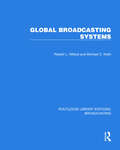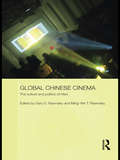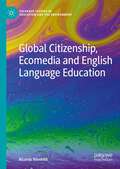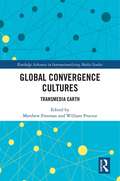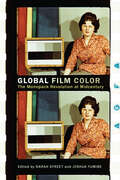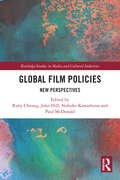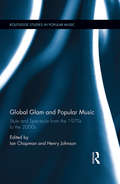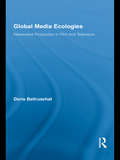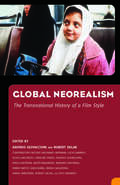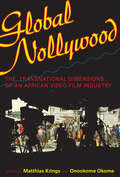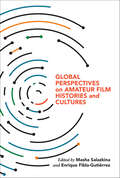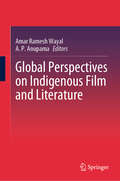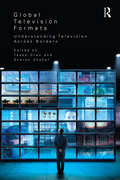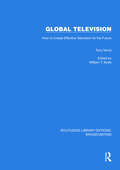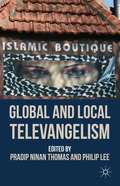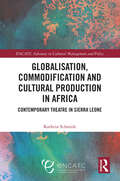- Table View
- List View
Global Broadcasting Systems (Routledge Library Editions: Broadcasting #21)
by Michael C. Keith Robert L. HilliardGlobal Broadcasting Systems (1996) provides a comprehensive look at broadcasting throughout the world. It covers every continent, region and almost every country in North and South America, Europe, Africa, Asia and Oceania. Within each geographical area, it presents the history, key issues, trends and status of broadcasting facilities and penetration; the control, regulation and management of networks and stations by government, domestic and foreign industry and the public; the financing of broadcasting systems; programming types and trends, including foreign imports; media freedom and censorship; and external radio and television services from other countries. The book discusses how new technology and political, social and economic factors influence the global media, and shows how increasing privatization has changed patterns of control and access.
Global Chinese Cinema: The Culture and Politics of 'Hero' (Media, Culture and Social Change in Asia)
by Gary D. RawnsleyThe film Hero, directed by Zhang Yimou and released in 2002, is widely regarded as the first globally successful indigenous Chinese blockbuster. A big expensive film with multiple stars, spectacular scenery, and astonishing action sequences, it touched on key questions of Chinese culture, nation and politics, and was both a domestic sensation and an international hit. This book explores the reasons for the film’s popularity with its audiences, discussing the factors which so resonated with those who watched the film. It examines questions such as Chinese national unity, the search for cultural identity and role models from China’s illustrious pre-communist past, and the portrayal of political and aesthetic values, and attitudes to gender, sex, love, and violence which are relatively new to China. The book demonstrates how the film, and China’s growing film industry more generally, have in fact very strong international connections, with Western as well as Chinese financing, stars recruited from the East Asian region more widely, and extensive interactions between Hollywood and Asian artists and technicians. Overall, the book provides fascinating insights into recent developments in Chinese society, popular culture and cultural production.
Global Cinematic Cities: New Landscapes of Film and Media
by Lawrence Webb Andersson JohanCinema and audiovisual media are integral to the culture, economy and social experience of the contemporary global city. But how has the relationship between cinema and the urban environment evolved in the era of digital technology, new media and globalization? And what are the critical tools and concepts with which we can grasp this vital interconnection between space and screen, viewer and built environment? Engaging with a rapidly transforming urban world, the contributions to this collection rethink the 'cinematic city' at a global scale. By presenting a global constellation of screen cities within one volume, the book encourages juxtapositions and comparisons across the North and South to capture the global city and its dynamics of exchange, hybridity, and circulation. The contributions examine film and screen cultures in a range of locations spanning five continents: Antibes, Beijing, Buenos Aires, Busan, Cairo, Caracas, Copenhagen, Jakarta, Kolkata, Lagos, Los Angeles, Malmö, Manila, Mumbai, Nairobi, Paris, Seoul, Sète, and Shanghai. The chapters address topics that range across the contemporary film and media landscape, from popular cinema, art cinema, and film festivals to serial television, public screens, multimedia installations, and video art. Contributors: Chris Berry, Yomi Braester, Jinhee Choi, Pei-Sze Chow, Thomas Elsaesser, Malini Guha, Jonathan Haynes, Will Higbee, Igor Krstic, Christian B. Long, Joanna Page, Lawrence Webb.
Global Cinematic Cities: New Landscapes of Film and Media
by Johan Andersson Lawrence WebbCapturing a rapidly transforming urban world, this collection investigates the emerging dynamics between filmmaking and urban change on a global scale. It surveys film, media and screen cultures in Buenos Aires, Beijing, Berlin, Cairo, Copenhagen, Delhi, Kolkata, Lagos, Los Angeles, Malmö, Manila, Paris, Rome, and Shanghai. Drawing on work in film and urban studies, the volume innovatively rethinks the "cinematic city" and argues for its ongoing relevance. Film festivals, transnational production, public screens, media ecologies, nostalgia, cinephilia, infrastructure, and informal economies illuminate the juxtaposition of cinema and urban space. Works covered include The Bourne Legacy (2012), Her (2013), Medianeras (2011), Last Flight to Abuja (2012), Maach, Mishti, and More (2013), The Future of the Past (2012), Good Morning Aman (2009), Couscous (2007), the transnational television production The Bridge, and Chinese video art.
Global Citizenship, Ecomedia and English Language Education (Palgrave Studies in Education and the Environment)
by Ricardo RömhildThis book presents a unique framework for the inclusion of ecomedia in the English language classroom to help learners cultivate global citizenship. Foregrounding learner agency in a world at risk, the author proposes a framework that hinges on human rights and critical eco-cosmopolitanism to help learners position themselves in discourses on climate change and act for transformation. The book discusses eco-documentaries as multimodal, factional texts against the background of cutting-edge research, refuting a definition based on the binary of fiction and non-fiction. Translating the insights gained from this discussion to the language education context, learners are conceptualised as active designers of meaning making when engaged with eco-documentaries. Based on this discussion, the book puts forth an innovative, multiliteracies-informed concept which is embedded in a sustainability-oriented pedagogy of hope, which encourages learners to learn and practice languages of hope and advocacy. The book will be of interest to scholars in the fields of ecopedagogy, sustainability education, global citizenship education and cultural learning, film pedagogy and language education, as well as language educators.
Global Convergence Cultures: Transmedia Earth (Routledge Advances in Internationalizing Media Studies)
by William Proctor Matthew FreemanToday’s convergent media industries readily produce stories that span multiple media, telling the tales of superheroes across comics, film and television, inviting audiences to participate in the popular universes across cinema, novels, the Web, and more. This transmedia phenomenon may be a common strategy in Hollywood’s blockbuster fiction factory, tied up with digital marketing and fictional world-building, but transmediality is so much more than global movie franchises. Different cultures around the world are now making new and often far less commercial uses of transmediality, applying this phenomenon to the needs and structures of a nation and re-thinking it in the form of cultural, political and heritage projects. This book offers an exploration of these national and cultural systems of transmediality around the world, showing how national cultures – including politics, people, heritage, traditions, leisure and so on – are informing transmediality in different countries. The book spans four continents and twelve countries, looking across the UK, Spain, Portugal, France, Estonia, USA, Canada, Colombia, Brazil, Japan, India, and Russia.
Global Film Color: The Monopack Revolution at Midcentury
by William Carroll Joshua Yumibe Philip Cavendish Kathryn Millard Sarah Street Laura Major Ranjani Mazumdar Stefan Soloman Kirsty Sinclair Dootson Kamalika Sanyal Heather Heckman Lydia Pappas Elena Gipponi Rafael de Luna Freire Josephine Diecke Linda Chen ZhangGlobal Film Color: The Monopack Revolution at Midcentury explores color filmmaking in a variety of countries and regions including India, China, Japan, and Russia, and across Europe and Africa. Most previous accounts of color film have concentrated on early 20th century color processes and Technicolor. Far less is known about the introduction and application of color technologies in the period from the mid-1940s to the 1980s, when photochemical, “monopack” color stocks came to dominate global film markets. As Eastmancolor, Agfacolor, Fujicolor and other film stocks became broadly available and affordable, national film industries increasingly converted to color, transforming the look and feel of global cinema. Covering a broad range of perspectives, the chapters explore themes such as transnational flows, knowledge exchange and transfer, the cyclical and asymmetrical circulation of technology in a global context, as well as the accompanying transformation of color film aesthetics in the postwar decades.
Global Film Policies: New Perspectives (Routledge Studies in Media and Cultural Industries)
by Ruby Cheung, John Hill, Nobuko Kawashima and Paul McDonaldGlobal Film Policies challenges conventional analyses of film policy as a stand-alone public policy confined within national boundaries and usually focused on supports for film production. The book argues for a more multi-faceted approach, extending beyond national boundaries and broadening its scope to recognise how other forms of policy pertain to film, including tax, labour, language and education.A team of experts in various areas of film and media studies critically analyse specific areas of film policy and engage with other public policy programmes, related concepts and/or phenomena. Each chapter brings together a general discussion of the conceptual and critical issues at stake, with specific references to particular territorial or historical contexts, institutions and policy initiatives that illuminate the more general issues. Case studies from different continents illustrate how film-related policies work with other public policies to maintain their influence not just on the film sector but also society more generally.This book will be an important resource for scholars and students studying global film policy in the areas of film, media or creative industries and business.
Global Glam and Popular Music: Style and Spectacle from the 1970s to the 2000s (Routledge Studies in Popular Music)
by Henry Johnson Ian ChapmanThis book is the first to explore style and spectacle in glam popular music performance from the 1970s to the present day, and from an international perspective. Focus is given to a number of representative artists, bands, and movements, as well as national, regional, and cultural contexts from around the globe. Approaching glam music performance and style broadly, and using the glam/glitter rock genre of the early 1970s as a foundation for case studies and comparisons, the volume engages with subjects that help in defining the glam phenomenon in its many manifestations and contexts. Glam rock, in its original, term-defining inception, had its birth in the UK in 1970/71, and featured at its forefront acts such as David Bowie, T. Rex, Slade, and Roxy Music. Termed "glitter rock" in the US, stateside artists included Alice Cooper, Suzi Quatro, The New York Dolls, and Kiss. In a global context, glam is represented in many other cultures, where the influences of early glam rock can be seen clearly. In this book, glam exists at the intersections of glam rock and other styles (e.g., punk, metal, disco, goth). Its performers are characterized by their flamboyant and theatrical appearance (clothes, costumes, makeup, hairstyles), they often challenge gender stereotypes and sexuality (androgyny), and they create spectacle in popular music performance, fandom, and fashion. The essays in this collection comprise theoretically-informed contributions that address the diversity of the world’s popular music via artists, bands, and movements, with special attention given to the ways glam has been influential not only as a music genre, but also in fashion, design, and other visual culture.
Global LGBTQ Health: Research, Policy, Practice, and Pathways (Global LGBTQ Health)
by Sel J. Hwahng Michelle R. KaufmanThis open access book is a groundbreaking volume that creates a new field within the intersection of “global health” and “LGBTQ health” delineating specific health challenges and resiliencies. There has been increasing awareness of the importance in recognizing LGBTQ health issues and disparities. However, there is a dearth of research and scholarship that examines LGBTQ health through global and comparative perspectives. This book addresses this gap.In the pursuit of scientific inquiry, the disciplines in public health have often emphasized reductionist perspectives that are particularized to a specific locale, municipality, or country. This book's provision of broader perspectives, cross-cutting disparities and issues, and socio-political-cultural contextualization inform the development of new research, policies, interventions, and programs. Students benefit by learning about LGBTQ health research, policies, and programs in various countries and regions. Public health researchers benefit by learning about research conducted in various countries and regions, along with understanding how research has been linked to and impacted by various policies and programs. Policymakers benefit from learning about overarching and comparative perspectives that could inform more effective policies, including those connected to multiple locations. Practitioners learn about various public health practices in multiple countries and regions that could contribute to novel and creative solutions and approaches within the respective contexts. The nine chapters of this volume facilitate greater socio-political-cultural awareness, sensitivity, and competence; undertake an in-depth literature review of health factors and outcomes; and provide recommendations for increasing health-related capacity through development and collaborations between agencies, organizations, and institutions across countries and/or regions. Global LGBTQ Health: Research, Policy, Practice, and Pathways is primarily intended for students and instructors in public health, medicine, nursing, other health professions, psychology, social work, LGBTQ or gender/sexuality studies, human rights, and the social sciences. The book is also a useful resource for public health researchers and practitioners, policymakers, and healthcare and social service providers.
Global Media Ecologies: Networked Production in Film and Television (Routledge Advances In Internationalizing Media Studies #6)
by Doris BaltruschatIn this study, Baltruschat calls attention to dramatic changes in worldwide media production. Her work provides new insights into industry re-organization, digital media, and audience interactivity as pivotal relationships are redrawn along the entire value chain of production, distribution, and consumption. Based on an international study, she details how cultural agents now negotiate a media landscape through collaborative ventures, co-productions and format franchising. These varied collaborations define the new global media economy and affect a shift across the entire field of cultural production. Through detailing the intricacies of globally networked production ecologies, Baltruschat elucidates the shifting power relations in media production, especially in regards to creative labor and trade of intellectual properties. In the new global economy, "content" has become the "new currency." As a result, relational dynamics between cultural agents emerge as key forces in shaping worldwide cultural production, now increasingly characterized by flexible production and consumption. The blurring of lines in international media developments require new parameters, which define creativity and intellectual property in relation to interactive audiences and collaboratively produced content. Baltruschat clearly maps and defines these new dynamics and provides solutions as to how creative labor constellations can advance and enrich the new media economy. This is especially pertinent as global film and TV production does not necessarily result in greater media diversity. On the contrary, interdependencies in policy regimes, prioritization of certain genres, and branded entertainment epitomize how current networked ecologies reflect broader trends in cultural and economic globalization.
Global Movie Magazine Networks
by Eric Hoyt and Kelley ConwayA free ebook version of this title is available through Luminos, University of California Press’s Open Access publishing program. Visit www.luminosoa.org to learn more. This groundbreaking collection of essays from leading film historians features original research on movie magazines published in China, France, Germany, India, Iran, Latin America, South Korea, the U.S., and beyond. Vital resources for the study of film history and culture, movie magazines are frequently cited as sources, but rarely centered as objects of study. Global Movie Magazine Networks does precisely that, revealing the hybridity, heterogeneity, and connectivity of movie magazines and the important role they play in the intercontinental exchange of information and ideas about cinema. Uniquely, the contributors in this book have developed their critical analysis alongside the collaborative work of building digital resources, facilitating the digitization of more than a dozen of these historic magazines on an open-access basis.
Global Neorealism: The Transnational History of a Film Style
by Saverio GiovacchiniContributions by Nathaniel Brennan, Luca Caminati, Silvia Carlorosi, Caroline Eades, Saverio Giovacchini, Paula Halperin, Neepa Majumdar, Mariano Mestman, Hamid Naficy, Sada Niang, Masha Salazkina, Sarah Sarzynski, Robert Sklar, and Vito ZagarrioIntellectual, cultural, and film historians have long considered neorealism the founding block of post-World War II Italian cinema. Neorealism, the traditional story goes, was an Italian film style born in the second postwar period and aimed at recovering the reality of Italy after the sugarcoated moving images of fascism. Lasting from 1945 to the early 1950s, neorealism produced world-renowned masterpieces such as Roberto Rossellini's Roma, città aperta (Rome, Open City, 1945) and Vittorio De Sica's Ladri di biciclette (Bicycle Thieves, 1947). These films won some of the most prestigious film awards of the immediate postwar period and influenced world cinema. This collection brings together distinguished film scholars and cultural historians to complicate this nation-based approach to the history of neorealism. The traditional story notwithstanding, the meaning and the origins of the term are problematic. What does neorealism really mean, and how Italian is it? Italian filmmakers were wary of using the term and Rossellini preferred "realism." Many filmmakers confessed to having greatly borrowed from other cinemas, including French, Soviet, and American. Divided into three sections, Global Neorealism examines the history of this film style from the 1930s to the 1970s using a global and international perspective. The first section examines the origins of neorealism in the international debate about realist esthetics in the 1930s. The second section discusses how this debate about realism was “Italianized” and coalesced into Italian “neorealism” and explores how critics and film distributors participated in coining the term. Finally, the third section looks at neorealism’s success outside of Italy and examines how film cultures in Latin America, Africa, Asia, and the United States adjusted the style to their national and regional situations.
Global Nollywood: The Transnational Dimensions of an African Video Film Industry (African Expressive Cultures)
by Matthias Krings and Onookome Okome“Reveals in fascinating detail the wild popularity, controversies, and complaints provoked by this film form . . . shap[ing] the media landscape of Africa.” —Brian Larkin, Barnard CollegeGlobal Nollywood considers this first truly African cinema beyond its Nigerian origins. In fifteen lively essays, this volume traces the engagement of the Nigerian video film industry with the African continent and the rest of the world. Topics such as Nollywood as a theoretical construct, the development of a new, critical film language, and Nollywood’s transformation outside of Nigeria reveal the broader implications of this film form as it travels and develops. Highlighting controversies surrounding commodification, globalization, and the development of the film industry on a wider scale, Global Nollywood gives sustained attention to Nollywood as a uniquely African cultural production.“Offers original material with respect to the transnational presence of Nollywood.” ?Moradewun Adejunmobi, University of California, Davis“Unveils a fascinating variety of the ways in which Nollywood cinema is viewed and interpreted.” ?Research in African Literatures“Delightfully entertaining yet appropriately erudite. . . . A welcome addition to the fields of film, media, African, and cultural studies.” —Cinema Journal“Highly recommended.” ?Choice“[T]he cumulative effect of [these] studies is to provide invaluable information for those wishing to keep up with where African cinema is today.” ?Journal of African History“Global Nollywood represents the most up-to-date research on Nollywood as a transnational cultural practice and is a must-read for scholars and students of African screen media.” —African Studies Review“Ground-breaking. . . . It proves that, in spite of appearing to be a niche market, Nollywood . . . can no longer be excluded from the canon of African cinema in the field of film studies.” ?African Affairs
Global Perspectives on Amateur Film Histories and Cultures
by Masha Salazkina and Enrique Fibla-GutiérrezFor too long, the field of amateur cinema has focused on North America and Europe. In Global Perspectives on Amateur Film Histories and Cultures, however, editors Masha Salazkina and Enrique Fibla-Gutiérrez fill the literature gap by extending that focus and increasing inclusivity. Through carefully curated essays, Salazkina and Fibla-Gutiérrez bring wider meaning and significance to the discipline through their study of alternative cinema in new territories, fueled by different historical and political circumstances, innovative technologies, and ambitious practitioners. The essays in this volume work to realize the radical societal democratization that shows up in amateur cinema around the world. In particular, diverse contributors highlight the significance of amateur filmmaking, the exhibition of amateur films, the uses and availability of film technologies, and the inventive and creative approaches of filmmakers and advocates of amateur film. Together, these essays shed new light on alternative cinema in a wide range of cities and countries where amateur films thrive in the shadow of commercial and conventional film industries.
Global Perspectives on Indigenous Film and Literature
by Amar Ramesh Wayal A. P. AnupamaThis edited volume comprehensively explores narrative survival in Indigenous film and literature, forging a literary and transitional approach to native writing. It navigates the evolution of Indigenous voices, spanning the oral tradition and literary forms from colonial times to the present. It covers a range of issues related to indigenous inequalities and diversities in film and literature. With chapters from global perspectives, including North America, Canada, New Zealand, and South Asia, it ensures an inclusive exploration of indigenous narratives. The diverse chapters address topics such as the aboriginal experience, residential school legacy, the invisible nation of Algonquins, tribal songs, decolonial futures, caste, survival narrative, trauma, and other marginalized groups such as low castes, linguistic minorities, and Adivasis (tribals). The book focuses on innovative concepts to understand the study of a particular indigenous group in isolation from others and more than the conventional comparative study of different indigenous groups. It deals with the challenges of achieving local indigenous rights and identities. It is a valuable resource for social science and humanities scholars, particularly for indigenous scholars, development professionals and administrators interested in the issues related to social diversity and indigeneity in a global setting.
Global Scriptwriting
by Ken DancygerGlobal Scriptwriting offers a look at an exciting new phase in screen storytelling, as writers and directors from all over the world infuse traditional forms with their own cultural values to create stories that have an international appeal and suggest a universality among readers, viewers, and listeners. A unique blend of screenwriting technique and film studies, Global Scriptwriting discusses screen stories as they have evolved through the years, focusing first on the basics of scriptwriting, then going on to afford a more sophisticated look at script via different models of scriptwriting: the Hollywood model, the independent model, the national model, and various alternative models. It examines the internationalization of storytelling, and illustrates how particular innovations have helped national screen stories to international success. This book is the first to incorporate the basics of the classical form with the innovative edge of the last decade, as well the culture specific changes that have taken place outside of North America. It offers readers a view of the enriched repertoire available to writers resulting from the introduction of cultural perspectives into traditional story forms. Specific topics examined include, the ascent of voice, the search for new forms, the struggle between style and content, and the centrality of megagenre.
Global TV: Exporting Television and Culture in the World Market
by C. Lee Harrington Denise D. BielbyA reporter for the Los Angeles Times once noted that “I Love Lucy is said to be on the air somewhere in the world 24 hours a day.” That Lucy’s madcap antics can be watched anywhere at any time is thanks to television syndication, a booming global marketplace that imports and exports TV shows. Programs from different countries are packaged, bought, and sold all over the world, under the watch of an industry that is extraordinarily lucrative for major studios and production companies.In Global TV, Denise D. Bielb and C. Lee Harrington seek to understand the machinery of this marketplace, its origins and history, its inner workings, and its product management. In so doing, they are led to explore the cultural significance of this global trade, and to ask how it is so remarkably successful despite the inherent cultural differences between shows and local audiences. How do culture-specific genres like American soap operas and Latin telenovelas so easily cross borders and adapt to new cultural surroundings? Why is The Nanny, whose gum-chewing star is from Queens, New York, a smash in Italy? Importantly, Bielby and Harrington also ask which kinds of shows fail. What is lost in translation? Considering such factors as censorship and other such state-specific policies, what are the inevitable constraints of crossing over?Highly experienced in the field, Bielby and Harrington provide a unique and richly textured look at global television through a cultural lens, one that has an undeniable and complex effect on what shows succeed and which do not on an international scale.
Global Tarantella: Reinventing Southern Italian Folk Music and Dances
by Incoronata InserraTarantella, a genre of Southern Italian folk music and dance, is an international phenomenon--seen and heard in popular festivals, performed across the Italian diaspora, even adapted for New Age spiritual practices. The boom in popularity has diversified tarantella in practice while setting it within a host of new, unexpected contexts. Incoronata Inserra ventures into the history, global circulation, and recontextualization of this fascinating genre. Examining tarantella's changing image and role among Italians and Italian Americans, Inserra illuminates how factors like tourism, translation, and world music venues have shifted the ethics of place embedded in the tarantella cultural tradition. Once rural, religious, and rooted, tarantella now thrives in settings urban, secular, migrant, and ethnic. Inserra reveals how the genre's changing dynamics contribute to reimagining Southern Italian identity. At the same time, they translate tarantella into a different kind of performance that serves new social and cultural groups and purposes. Indeed, as Inserra shows, tarantella's global growth promotes a reassessment of gender relations in the Italian South and helps create space for Italian and Italian-American women to reclaim gendered aspects of the genre.
Global Telecommunications: The Technology, Administration and Policies (Routledge Library Editions: Broadcasting #22)
by Raymond AkwuleGlobal Telecommunications (1992) clarifies the complex, politically-charged arena of international telecommunications. By understanding both the demands created by dynamic Western countries in the grips of deregulation and the needs of developing nations, readers acquire an appreciation for the challenges facing global telecommunications users, developers and policymakers. This book stresses the growing need for sophisticated management of satellite and communication resources. The emerging global information society is propelled by technological innovations, and these developments are shaping the way the world’s population receives information.
Global Television Formats: Understanding Television Across Borders
by Tasha Oren Sharon ShahafWinner of the 2013 SCMS Best Edited Collection Award For decades, television scholars have viewed global television through the lens of cultural imperialism, focusing primarily on programs produced by US and UK markets and exported to foreign markets. Global Television Formats revolutionizes television studies by de-provincializing its approach to media globalization. It re-examines dominant approaches and their legacies of global/local and center/periphery, and offers new directions for understanding television’s contemporary incarnations. The chapters in this collection take up the format phenomena from around the globe, including the Middle East, Western and Eastern Europe, South and West Africa, South and East Asia, Australia and New Zealand, North America, South America, and the Caribbean. Contributors address both little known examples and massive global hits ranging from the Idol franchise around the world, to telenovelas, dance competitions, sports programming, reality TV, quiz shows, sitcoms and more. Looking to global television formats as vital for various cultural meanings, relationships, and structures, this collection shows how formats can further our understanding of television and the culture of globalization at large.
Global Television: How to Create Effective Television for the Future (Routledge Library Editions: Broadcasting #23)
by Tony VernaGlobal Television (1993) looks at how satellites, fibre optics, compressed digital transmission, and interactive and high-definition television have converged with computer technology to revolutionise TV and film production, TV sets and even the smart home in which TV is viewed. Its provides valuable insight into how new technologies and viewer demands have combined to transform television into a truly global medium.
Global Theme Park Industry
by Salvador Anton ClavéSince the 1980s, the theme park industry has developed into a global phenomenon, with everything from large, worldwide theme parks to countless smaller ventures. From the first pleasure gardens to the global theme park companies, this book provides an understanding of the nature and function of theme parks as spaces of entertainment. Illustrated throughout by worldwide case studies, empirical data and practical examples, the book portrays the impacts of theme parks as global competitive actors, agents of global development and cultural symbols, particularly in the context of their role in the developing experience economy.In conclusion, this book is a practical guide to the planning and development of theme parks.
Global and Local Televangelism
by Pradip Ninan Thomas Philip LeeAn exploration of the many faces of televangelism in our world today, including Christian, Islamic and Hindu. The collection analyses the correspondences and major differences between global and local televangelism, focusing on the main individuals involved in televangelism, their practices and the social and cultural impact of their ministries.
Globalisation, Commodification and Cultural Production in Africa: Contemporary Theatre in Sierra Leone (ENCATC Advances in Cultural Management and Policy)
by Kathrin SchmidtThis book engages with contemporary cultural production in Africa, focusing on theatre in Sierra Leone as main case study. The author provides coverage of, and insights into, such themes as cultural globalisation, commodification, the global creative economy, culture and development, international relations and contemporary cultural production in Sierra Leone within the context of local and global flows of people, media, images, technologies, finance and ideas. Combining the analysis of theatre in Sierra Leone and its aesthetics with its policy, structural and institutional context, this book highlights in much detail and nuance the interconnectedness between the micro- and the macro-levels of cultural production, between the local and the global, and between aesthetics, politics, policy, governance structures and institutions. This book links the particular findings from the author’s fieldwork to larger issues of contemporary local cultural production within the context of globalisation, commodification and decolonisation; adds a postcolonial perspective to existing theories and approaches to cultural production, management and policy, which is still largely missing from the existing discourse; and also contributes to addressing the gap in the knowledge about the context of contemporary cultural productions in diverse African contexts. This book will be particularly useful for both theatre scholars with an interest in the political economy of theatre and, more broadly, those seeking to understand the nuanced challenges and opportunities faced by policymakers, artists and arts managers to embrace the cultural and creative industries in this context. It also offers excellent insights for policymakers who wish to improve their understanding and interventions beyond superficial ‘best practice’ snippets and simplified ‘success stories’.
